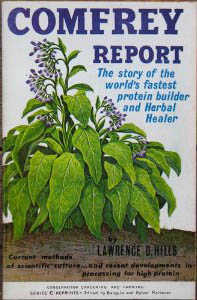



|
Cultivation of Comfrey; Medicinal and Food Uses for People and Livestock, Volume 2
Chapter 25: Personal / Clinical Observations of Healing, pages 130-131
Broken Bones (also see Osteoporosis)
“To promote the union of bone. Take Comfrey, and bruise with wine, pepper and honey, drinking it daily for nine days, and they will unite compactly.”
-‘The Physicians of Myddvai; Meddygon Myddvai, or The Medical Practice of the Celebrated Riwallon and His Sons, of Myddvai (Myddfai), in Caemarthenshire (Wales), Physicians to Rhys Gryg, Lord of Dynevor and Ystrad Towy, About the Middle of the Thirteenth Century’, English translation by John Pughe, edited by Reverend John Williams Ab Ithel, for Welsh MSS Society, published in Llandovery, Wales and London, England, 1861, page 78.
“Mr. Cockayne relates that the locksman at Teddington (south London, England) informed him how the bone of his little finger being broken, was grinding and grunching so sadly for two months, that sometimes he felt quite wrong in his head.
One day he saw a doctor go by, and told him about the distress. The doctor said: ‘You see that Comfrey growing there? Take a piece of its root, and champ (chop) it, and put it about your finger, and wrap it up.’ The man did so, and in four days his finger was well.”
-‘Herbal Simples Approved for Modern Uses of Cure’ by W.T. Fernie, M.D., Bristol, England, 1897.
The same story about the broken finger was told in this book with more added to it:
“Perhaps herbs are more really effectual than we shall easily believe. This story struck me the more since Comfrey is the ‘confirma’ of the middle ages, and the ‘symfyto’ of the Greeks, both which names seem to attribute to the plant the same consolidating virtue. Besides the instances in the medical treatises which survive, and which are the less characteristic as they are borrowed, we find the healing power of worts spoken of as a thing of course.”
-‘Leechdoms, Wortcunning and Starcraft: Being a Collection of Documents Illustrating the History of Science Before the Norman Conquest, Volumes 1-3’ also called ‘Chronicles and Memorials of Great Britain and Ireland During the Middle Ages’ edited by Thomas Oswald Cockayne, London, England, 1864. Volume 1, preface liii.
(The Norman Conquest of England was an 11th-century invasion and occupation of England by Norman, Breton, Flemish and French soldiers.)
(Worts are plants used as medicine. Examples include Bellwort, Dragonwort, Figwort, Honeywort, Lungwort a nd Saint Johns Wort. Most of these names come from the 1600s or earlier.)
“Symphyti Radix (root), Common Comfrey root, Symphytum officinale: The black rind (outside of the root) is scraped off, and the mucilaginous root is then scraped carefully into a nice even pulp.
This spread to the thickness of a crownpiece (4 mm or 1/8 inch) upon cambric or old muslin (cloth), is wrapped round the limb and bandaged over; it soon stiffens, and forms a casing (cast) superior to starch, giving great support and strength to the part.
The late author knew a bone-setter who practised more than fifty years ago, and rendered himself famous by treating fractures after this method, which he kept secret, the bandage not being removed until the limb was well.”
-‘Squires Companion to the Latest Edition of the British Pharmacopoeia: Comparing the Strength of Its Various Preparations with those of the United States and Other Foreign Pharmacopoeias, 17th edition’ by Peter Squire, London, England, 1899, page 619.
“Some idea of the traditional therapeutic virtues of Comfrey may be gathered from the names by which it was popularly known. For instance ‘Knitbacke’ (Gerard, 1597), ‘Comfort Knitbene’ (Scotland), in Aberdeen (Scotland) it was called ‘Comfer Knitbeen’, and a prepartion made by boiling the root in oil or lard was extolled by old women for hardening and strengthening fractures. This property also accounted for its being called ‘Bone-set’ or ‘Knit Bone’ in Lancashire (County, England).
It appears to have been used both internally and externally in fractures in all districts.”
-The Medicinal Uses of Comfrey by Dr. Charles MacAlister, M.D., F.R.C.P., 1935. (in ‘Comfrey: Fodder, Food & Remedy’)
“Comfrey, Symphytum officinale: also called Knitbone, Nipbone and Blackwort. Is used by many Gypsies to bind broken bones, and was known in this connection as long ago as the time of Pliny (23-79 AD).”
-’Gypsies of Britain: An Introduction to Their History’ by Brian Vesey-Fitzgerald, FLS, FRES, MBOU. London, England; Chapman & Hall, Ltd., 1944, page 141.
“Mrs. C. reports: ‘I fractured small bone in foot about 18 months ago and was in plaster (cast) for three weeks and gradually restored to normal function.
About a month ago I slipped and badly strained the previously damaged foot which became so painful I had difficulty walking. I took some Comfrey ointment which I applied daily, and the pain disappeared in about three days.”
-Comfrey: The Herbal Healer by Henry Doubleday Research Association, 1975, 41 pages, page 15. (Included in ‘Comfrey Report’ book.)
|



